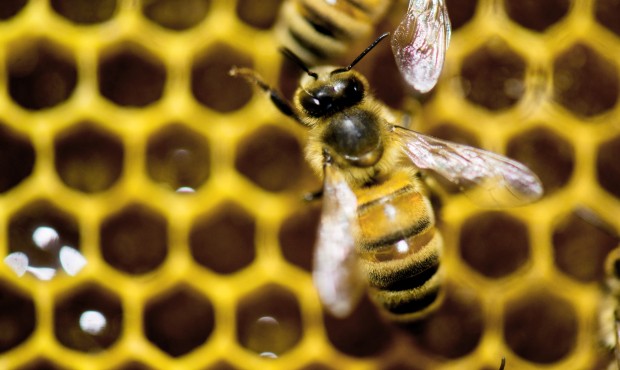To fight bee decline, Obama proposes more land to feed bees
May 19, 2015, 10:31 AM

FILE - In this Jan. 28, 2014, file photo, a hive of honeybees appears on display at the Vermont Beekeeping Supply booth at the annual Vermont Farm Show at the Champlain Valley Expo in Essex Junction, Vt. The federal government hopes to reverse America's declining honeybee and monarch butterfly populations by making more federal land bee-friendly, spending more money on research and considering the use of less pesticides. (AP Photo/Andy Duback, File)n
(AP Photo/Andy Duback, File)
WASHINGTON (AP) — The Obama administration hopes to save the bees by feeding them better.
A new federal plan aims to reverse America’s declining honeybee and monarch butterfly populations by making millions of acres of federal land more bee-friendly, spending millions of dollars more on research and considering the use of fewer pesticides.
While putting different type of landscapes along highways, federal housing projects and elsewhere may not sound like much in terms of action, several bee scientists told The Associated Press that this a huge move. They say it may help pollinators that are starving because so much of the American landscape has been converted to lawns and corn that don’t provide foraging areas for bees.
“This is the first time I’ve seen addressed the issue that there’s nothing for pollinators to eat,” said University of Illinois entomologist May Berenbaum, who buttonholed President Barack Obama about bees when she received her National Medal of Science award last November. “I think it’s brilliant.”
Environmental activists who wanted a ban on a much-criticized class of pesticide said the Obama administration’s bee strategy falls way short of what’s needed to save the hives.
Scientists say bees — crucial to pollinate many crops — have been hurt by a combination of declining nutrition, mites, disease, and pesticides. The federal plan is an “all hands on deck” strategy that calls on everyone from federal bureaucrats to citizens to do what they can to save bees, which provide more than $15 billion in value to the U.S. economy, according to White House science adviser John Holdren.
“Pollinators are struggling,” Holdren said in a blog post, citing a new federal survey that found beekeepers lost more than 40 percent of their colonies last year, although they later recovered by dividing surviving hives. He also said the number of monarch butterflies that spend the winter in Mexico’s forests is down by 90 percent or more over the past two decades, so the U.S. government is working with Mexico to expand monarch habitat in the southern part of that country.
The plan calls for restoring 7 million acres of bee habitat in the next five years. Numerous federal agencies will have to find ways to grow plants on federal lands that are more varied and better for bees to eat because scientists have worried that large land tracts that grow only one crop have hurt bee nutrition.
The plan is not just for the Department of Interior, which has vast areas of land under its control. Agencies that wouldn’t normally be thought of, such as Housing and Urban Development and the Department of Transportation, will have to include bee-friendly landscaping on their properties and in grant-making.
That part of the bee plan got praise from scientists who study bees.
“Here, we can do a lot for bees, and other pollinators,” University of Maryland entomology professor Dennis van Englesdorp, who led the federal bee study that found last year’s large loss. “This I think is something to get excited and hopeful about. There is really only one hope for bees and it’s to make sure they spend a good part of the year in safe healthy environments. The apparent scarcity of these areas is what’s worrying. This could change that.”
University of Montana bee expert Jerry Bromenshenk said the effort shows the federal government finally recognizes that land use is key with bees.
“From my perspective, it’s a wake-up call,” Bromenshenk wrote in an email. “Pollinators need safe havens, with adequate quantities of high-quality resources for food and habitat, relatively free from toxic chemicals, and that includes pollutants as well as pesticides and other agricultural chemicals.”
Berenbaum said what’s impressive is that the plan doesn’t lay the problem or the solution just on agriculture or the federal government: “We all got into this mess and we’re going to have to work together to get out of it,” she said.
The administration proposes spending $82.5 million on honeybee research in the upcoming budget year, up $34 million from now.
The Environmental Protection Agency will step up studies into the safety of widely used neonicotinoid pesticides, which have been temporarily banned in Europe. It will not approve new types of uses of the pesticides until more study is done, if then, the report said.
“They are not taking bold enough action; there’s a recognition that there is a crisis,” said Lori Ann Burd, environmental health director for the advocacy group Center for Biological Diversity. She said the bees cannot wait, comparing more studies on neonicotinoids to going to a second and third mechanic when you’ve been told the brakes are shot.
“Four million Americans have called on the Obama administration to listen to the clear science demanding that immediate action be taken to suspend systemic bee-killing pesticides, including seed treatments,” Friends of the Earth food program director Lisa Archer said in statement. “Failure to address this growing crisis with a unified and meaningful federal plan will put these essential pollinators and our food supply in jeopardy.”
But CropLife America, which represents the makers of pesticides, praised the report for its “multi-pronged coordinated approach.”
The report talks of a fine line between the need for pesticides to help agriculture and the harm they can do to bees and other pollinators.
Lessening “the effects of pesticides on bees is a priority for the federal government, as both bee pollination and insect control are essential to the success of agriculture,” the report said.
___
The White House bee strategy: http://1.usa.gov/1Ad2DUE
___
Seth Borenstein can be followed at http://twitter.com/borenbears
Copyright © The Associated Press. All rights reserved. This material may not be published, broadcast, rewritten or redistributed.








